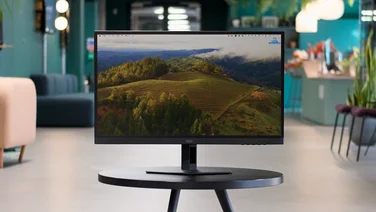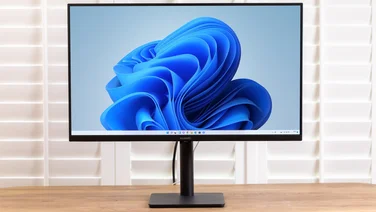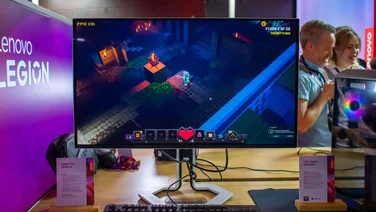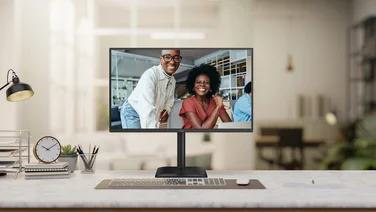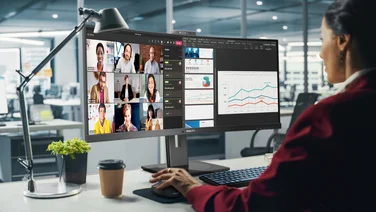To help us provide you with free impartial advice, we may earn a commission if you buy through links on our site. Learn more

Doing more with less is something we can all aspire to achieve. The secret is to be mindful of unnecessary complexity. Take your desk, for instance. If you’re working with multiple monitors, docking stations, hubs and peripherals, anything that makes it easier to connect can save you from running up the clock. This means more time for your next project – or all those other things on your to-do list.
Philips’s 6000-series range of business monitors tackle the needs of the modern desk head on. Capitalising on the potential of high-end laptops, every model offers single-cable USB-C convenience, and high-speed Thunderbolt 4 support. There are also KVM switch features for quickly swapping between machines while retaining unfettered access to your peripherals, data and network connections.
Simply plug a single cable into any one of these monitors, and even today’s most frugally equipped laptops can provide desktop levels of connectivity.
Read on and we’ll lead you through the four monitors in the 6000-series and pinpoint all the key features, in addition to how the four models might suit different users.
Philips 6000-series monitors: At a glance
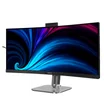
Philips 34B2U6603CH
34in VA | 120Hz | 21:9 UltraWide Curved 1500R | 3,440 x 1,440 | 120% sRGB, 101% NTSC | DisplayHDR 400 | 5.0MP webcam (pop-up, noise-cancelling mic, Windows Hello support) | 180mm height adjustment | Best for: Ultrawide productivity at a sensible price
£650 (starting price)
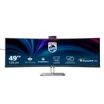
Philips 49B2U6903CH
48.8in VA | 100Hz | 32:9 SuperWide Curved 1800R | 5,120 x 1,440 | 119% sRGB, 97% NTSC | DisplayHDR 400 | 5.0MP webcam (pop-up, noise-cancelling mic, Windows Hello support) | 150mm height adjustment | Best for: Replacing dual QHD monitors with one super ultrawide panel
£1067 (starting from)
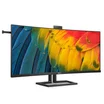
Philips 40B1U6903CH
39.7in IPS | 75Hz | 21:9 UltraWide Curved 2500R | 5,120 x 2,160 | 134% sRGB, 98% DCI-P3 | 5.0MP webcam (pop-up, noise-cancelling mic, Windows Hello support) | 150mm height adjustment | Best for: Pristine 5K2K ultrawide with wide-gamut colour
£1399 (starting from)
1. One cable, many benefits
The advent of USB-C connectivity on monitors is probably one of the simplest and greatest time-savers that we’ve experienced in modern technology. Where once multiple cables and manufacturer-specific power bricks were a must, you can now do everything with a single USB-C cable – plug it in and it can charge your laptop’s battery, carry high-res audio, 4K video and high-speed data all at once.
Add Thunderbolt 4 support to the mix and you now have a whopping 40Gbits/sec of bandwidth. That’s four times the bandwidth of the fastest USB 3.2 Gen 2 devices (10Gbits/sec), and it’s all at your disposal to send audio, data and video, all at once.
With just a single cable from your slimline laptop, you can daisy-chain an additional monitor and a fleet of Thunderbolt 4 peripherals and storage appliances. If you need to tackle the most demanding projects with ease, then a single cable gets you up and running in seconds.
2. Pristine image quality
Every model in the family provides crisp, high resolution visuals, ranging from the 34-inch 34B2U6603CH right up to the 49-inch 49B2U6903CH with its pin-sharp 5K2K canvas. That means it doesn’t matter how big your desk is, there’s a monitor in the range that can make the most of the space you have.
Image quality is about more than pure pixel count, however, and all three of the 6000-series monitors promise the kind of colour response you can rely on. Every model provides guaranteed colour accuracy: Philips’ factory calibration process ensures that every monitor has a measured Delta E of less than 2 in sRGB mode – and in layman’s terms, that means every colour you see is accurate and true.
Combine that pristine colour palette with ultrawide resolutions, and the sheer impact from the 34in, 40in and 49in displays is hard to convey in words. The curved panels provide a wrap-around display that’s easier on the eye than dual displays, and this makes all the difference for productivity. Just don’t be tempted to load up any games – your output may take a nosedive.
3. All-day comfort and adjustability
Anyone who works for long periods in front of a monitor knows that adjustability makes the difference between working effectively and a nasty neck ache at the end of the day.
Even the simplest ergonomic features can have a huge impact. Every 6000-series monitor here offers tilt, swivel and generous height adjustment, so you can get things just right – whatever your setup. For those few desk arrangements that are more esoteric, you can fall back on the VESA 100 x 100mm mount for affixing the monitors to wall mounts or adjustable arms.
One overlooked feature of the curved models is the integrated webcam. This pops out of the top edge of the display, provides a decent 5-megapixel image and also has an infrared sensor for Windows Hello support.
That might not sound particularly exciting, but there’s a practical benefit of having a webcam positioned on top of your monitor – it points down towards your face, making for a far more flattering angle than a laptop camera. And as it’s consistently positioned, there’s no need to tilt your laptop display at an awkward angle to get the perfect image. If you want to make a great first impression, a consistent appearance on video calls is a big deal.
4. Multi-monitor benefits with a single monitor
While many people understandably prefer multi-monitor setups, not every home or office desk can accommodate two screens side by side – let alone three or more. That’s why picking a monitor that packs the most usable screen space into the smallest footprint is an easy way to optimise your working environment.
In particular, there’s a lot to be said for ultrawide format displays. For businesses or individuals on a tighter budget, the 34in ultrawide model – the £560 34B2U6603CH – measures 80cm wide, only 20cm wider than a standard 27in monitor, yet still gives the equivalent of two 4:3 displays side by side. With the Picture by Picture (PBP) and Picture in Picture (PIP) features present and correct, you can still work with two machines simultaneously on the same display.
Need more pixels, improved colour depth or just a larger display full stop? Then the 40in and 49in models in the family step up the screen size and resolution without skimping on any of the features, while packing in 98% and 91% DCI-P3 colour coverage respectively.
5. Energy-saving features take centre stage
These monitors might be big and bold, but they won’t set your energy bills spiralling. Both presence and brightness sensors are built into every monitor, with the former turning off the display when the user walks away, and the latter dialling down the brightness to suit the current ambient lighting conditions.
The presence-sensing feature, dubbed PowerSensor, ensures that your monitor doesn’t waste power when you leave your desk. Head off for a meeting or cup of coffee and, after a minute, the backlight dims down to barely on. After another minute, the monitor sleeps.
The LightSensor control simply adjusts the brightness based on your room’s lighting conditions. It reacts slowly to light changes, so won’t flicker up and down if the sun is peeking out behind clouds, dialling brightness up and down gradually to try and maximise legibility in all conditions.
The four models in Philips’ 6000-series are all available now from retailers including Amazon.co.uk, Laptops Direct and Currys. Want to learn more first? Then head over to Philips’s website to browse through all the models and explore their various features and specifications.


